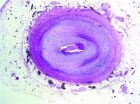(Press-News.org) Researchers have uncovered a fundamental link between the two defining properties of quantum physics. Stephanie Wehner of Singapore's Centre for Quantum Technologies and the National University of Singapore and Jonathan Oppenheim of the United Kingdom's University of Cambridge published their work today in the latest edition of the journal Science.
The result is being heralded as a dramatic breakthrough in our basic understanding of quantum mechanics and provides new clues to researchers seeking to understand the foundations of quantum theory. The result addresses the question of why quantum behaviour is as weird as it is—but no weirder.
The strange behaviour of quantum particles, such as atoms, electrons and the photons that make up light, has perplexed scientists for nearly a century. Albert Einstein was among those who thought the quantum world was so strange that quantum theory must be wrong, but experiments have borne out the theory's predictions.
One of the weird aspects of quantum theory is that it is impossible to know certain things, such as a particle's momentum and position, simultaneously. Knowledge of one of these properties affects the accuracy with which you can learn the other. This is known as the "Heisenberg Uncertainty Principle".
Another weird aspect is the quantum phenomenon of non-locality, which arises from the better-known phenomenon of entanglement. When two quantum particles are entangled, they can perform actions that look as if they are coordinated with each other in ways that defy classical intuition about physically separated particles.
Previously, researchers have treated non-locality and uncertainty as two separate phenomena. Now Wehner and Oppenheim have shown that they are intricately linked. What's more, they show that this link is quantitative and have found an equation which shows that the "amount" of non-locality is determined by the uncertainty principle.
"It's a surprising and perhaps ironic twist," said Oppenheim, a Royal Society University Research Fellow from the Department of Applied Mathematics & Theoretical Physics at the University of Cambridge. Einstein and his co-workers discovered non-locality while searching for a way to undermine the uncertainty principle. "Now the uncertainty principle appears to be biting back."
Non-locality determines how well two distant parties can coordinate their actions without sending each other information. Physicists believe that even in quantum mechanics, information cannot travel faster than light. Nevertheless, it turns out that quantum mechanics allows two parties to coordinate much better than would be possible under the laws of classical physics. In fact, their actions can be coordinated in a way that almost seems as if they had been able to talk. Einstein famously referred to this phenomenon as "spooky action at a distance".
However, quantum non-locality could be even spookier than it actually is. It's possible to have theories which allow distant parties to coordinate their actions much better than nature allows, while still not allowing information to travel faster than light. Nature could be weirder, and yet it isn't – quantum theory appears to impose an additional limit on the weirdness.
"Quantum theory is pretty weird, but it isn't as weird as it could be. We really have to ask ourselves, why is quantum mechanics this limited? Why doesn't nature allow even stronger non-locality?" Oppenheim says.
The surprising result by Wehner and Oppenheim is that the uncertainty principle provides an answer. Two parties can only coordinate their actions better if they break the uncertainty principle, which imposes a strict bound on how strong non-locality can be.
"It would be great if we could better coordinate our actions over long distances, as it would enable us to solve many information processing tasks very efficiently," Wehner says. "However, physics would be fundamentally different. If we break the uncertainty principle, there is really no telling what our world would look like."
How did the researchers discover a connection that had gone unnoticed so long? Before entering academia, Wehner worked as a 'computer hacker for hire', and now works in quantum information theory, while Oppenheim is a physicist. Wehner thinks that applying techniques from computer science to the laws of theoretical physics was key to spotting the connection. "I think one of the crucial ideas is to link the question to a coding problem," Wehner says. "Traditional ways of viewing non-locality and uncertainty obscured the close connection between the two concepts."
Wehner and Oppenheim recast the phenomena of quantum physics in terms that would be familiar to a computer hacker. They treat non-locality as the result of one party, Alice, creating and encoding information and a second party, Bob, retrieving information from the encoding. How well Alice and Bob can encode and retrieve information is determined by uncertainty relations. In some situations, they found that and a third property known as "steering" enters the picture.
Wehner and Oppenheim compare their discovery to uncovering what determines how easily two players can win a quantum board game: the board has only two squares, on which Alice, can place a counter of two possible colours: green or pink. She is told to place the same colour on both squares, or to place a different colour on each. Bob has to guess the colour that Alice put on square one or two. If his guess is correct, Alice and Bob win the game. Clearly, Alice and Bob could win the game if they could talk to each other: Alice would simply tell Bob what colours are on squares one and two. But Bob and Alice are situated so far apart from each other that light – and thus an information-carrying signal – does not have time to pass between them during the game.
If they can't talk, they won't always win, but by measuring on quantum particles, they can win the game more often than any strategy which doesn't rely on quantum theory. However, the uncertainty principle prevents them from doing any better, and even determines how often they lose the game.
The finding bears on the deep question of what principles underlie quantum physics. Many attempts to understand the underpinnings of quantum mechanics have focused on non-locality. Wehner thinks there may be more to gain from examining the details of the uncertainty principle. "However, we have barely scratched the surface of understanding uncertainty relations," she says.
The breakthrough is future-proof, the researchers say. Scientists are still searching for a quantum theory of gravity and Wehner and Oppenheim's result concerning non-locality, uncertainty and steering applies to all possible theories – including any future replacement for quantum mechanics.
INFORMATION:
Researchers uncover surprise link between weird quantum phenomena
Heisenberg Uncertainty Principle sets limits on Einstein's 'spooky action at a distance,' new research finds
2010-11-19
ELSE PRESS RELEASES FROM THIS DATE:
Panama Canal, Panama City at risk of large earthquake, says new research
2010-11-19
Panama Canal, PanNew data suggest that the Limon and Pedro Miguel faults in Central Panama have ruptured both independently and in unison over the past 1400 years, indicating a significant seismic risk for Panama City and the Panama Canal, according to research published today by the Bulletin of the Seismological Society of America (BSSA).
The Panama Canal is undergoing expansion to allow for greater traffic of larger ships, scheduled for completion by 2014. As part of a seismic hazard characterization for the Panama Canal Authority (ACP) expansion project, Rockwell, ...
Planet from another galaxy discovered
2010-11-19
Over the last 15 years, astronomers have detected nearly 500 planets orbiting stars in our cosmic neighbourhood, but none outside our Milky Way has been confirmed [1]. Now, however, a planet with a minimum mass 1.25 times that of Jupiter [2] has been discovered orbiting a star of extragalactic origin, even though the star now finds itself within our own galaxy. It is part of the so-called Helmi stream — a group of stars that originally belonged to a dwarf galaxy that was devoured by our galaxy, the Milky Way, in an act of galactic cannibalism about six to nine billion years ...
Paleovirology expanded: Non-retroviral virus fragments found in animal genomes
2010-11-19
Understanding the evolution of life-threatening viruses like influenza, Ebola and dengue fever, could help us to minimize their impact. New research points the way to a fossil record of viruses that have insinuated themselves into the genomes of insects and other animals, providing clues about their evolutionary history. The findings, published online on November 18 in the open-access journal PLoS Genetics, could enable scientists to elucidate general principles in virus evolution from their genetic "fossils", which in turn could inform approaches for controlling disease.
Robert ...
Scripps Research scientists report molecular structure of dopamine receptor
2010-11-19
LA JOLLA, CA – November 16, 2010 – A team led by scientists at The Scripps Research Institute has solved the structure of one of the receptors that responds to the neurotransmitter dopamine. Although dopamine transmission is essential to normal brain functioning, the biological assembly of the molecules involved in this crucial neuronal interplay had not been known—until now.
The work was reported in the November 19, 2010, issue of the journal Science.
In the new study, whose authors included collaborators from Weill Cornell Medical College, Receptos, the National Institute ...
Paw prints and feces offer new hope for saving tigers
2010-11-19
As experts gather in St Petersburg, Russia for next week's Tiger Summit, fewer than 3,200 tigers survive in the wild worldwide. More than half live in India, where they are spread over a vast area (100,000 sq km) of forest.
According to Dr Yadvendradev Jhala of the Wildlife Institute of India, lead author of the new study: "Tigers are cryptic, nocturnal and occur at low densities so they are extremely difficult to monitor. Unless we know how many tigers are left in the wild, and whether their numbers are increasing or decreasing, we will not be able to conserve them."
Until ...
Cough medicine could help doctors identify how breast cancer patients metabolize tamoxifen
2010-11-19
Cough medicine could be used as way of predicting how well individual patients metabolise tamoxifen used in the treatment of their breast cancer, according to new research presented at the 22nd EORTC-NCI-AACR [1] Symposium on Molecular Targets and Cancer Therapeutics in Berlin today (Friday).
The findings suggest that it could be possible to use cough suppressant syrup as a probe, which would enable doctors to identify patients with altered metabolism and use this information to improve individual treatment, making it more effective and reducing the chances of side-effects. ...
Researchers find new target for stopping tumors developing their own blood supply
2010-11-19
Researchers have found that a newly developed drug, which is aimed at a particular receptor involved in the development of blood vessels that sustain tumour growth, is active in patients with advanced cancers and, in some cases, has halted the progress of the disease. The drug, ACE-041, targets a different molecular pathway to other anti-angiogenesis drugs and may provide a new option to treat cancer.
Results from a phase I clinical study of ACE-041 were presented at the 22nd EORTC-NCI-AACR [1] Symposium on Molecular Targets and Cancer Therapeutics in Berlin today (Friday). ...
UCLA team uncovers mechanism behind organ transplant rejection
2010-11-19
UCLA researchers have pinpointed the culprit behind chronic rejection of heart, lung and kidney transplants. Published in the Nov. 23 edition of Science Signaling, their findings suggest new therapeutic approaches for preventing transplant rejection and sabotaging cancer growth.
The team focused on the mechanism behind narrowing of the donor's grafted blood vessels, which blocks blood from reaching the transplanted organ. Starved of oxygen and other nutrients, the organ eventually fails, forcing the patient back on the transplant waiting list.
"Chronic rejection ...
In fending off diseases, plants and animals are much the same, research shows
2010-11-19
It may have been 1 billion years since plants and animals branched apart on the evolutionary tree but down through the ages they have developed strikingly similar mechanisms for detecting microbial invasions and resisting diseases.
This revelation was arrived at over a period of 15 years by teams of researchers from seemingly disparate fields who have used classical genetic studies to unravel the mysteries of disease resistance in plants and animals, according to a historical overview that will appear in the Nov. 19 issue of the journal Science.
The report, written ...
Global economic woes make universal access to aids drugs unlikely, Stanford analysis shows
2010-11-19
STANFORD, Calif. — Universal access to lifesaving AIDS drugs — a United Nations' Millennium Development Goal that officials hoped to accomplish by 2010 — would require a staggering $15 billion annual investment from the international community at a time when the economic downturn is challenging continued funding for relief efforts, according to a new analysis by researchers at the Stanford University School of Medicine.
The study underscores the need for groups combating AIDS to rethink how they allocate scarce resources, as what was once the centerpiece of the movement ...
LAST 30 PRESS RELEASES:
Common eye ointment can damage glaucoma implants, study warns
ACCESS-AD: a new European initiative to accelerate timely and equitable AD diagnosis, treatment and care
Mercury exposure in northern communities linked to eating waterfowl
New Zealand researchers identify brain link to high blood pressure
New research confirms people with ME/CFS have a consistent faulty cellular structure
Hidden cancer risk behind fatty liver disease targets
Born in brightness, leading to darkness
Boron-containing Z-type and bilayer benzoxene
Hong Kong researchers break the single-field barrier with dual-field assisted diamond cutting
Work hard, play hard?
Wood becomes smart glass: Photo- and electro-chromic membrane switches tint in seconds
The Lancet: COVID-19 vaccine hesitancy decreased over time, though mistrust persists among certain groups, study of over 1 million people in England suggests
Psychosis patients ‘living in metaphor’ -- new study radically shifts ideas about delusions
Clinical trial in Ethiopia targets the trachoma scourge
Open-sourcing the future of food
Changes in genetic structure of yeast lead to disease-causing genomic instabilities
UC San Diego Health Sciences Grant Writing Course helps launch successful research careers
Study: Many head and neck cancer trials end early. Why?
Tufts vice provost for research named Foreign Fellow of Indian National Science Academy
New model improves prediction of prostate cancer death risk
Two wrongs make a right: how two damaging variants can restore health
Overlooked decline in grazing livestock brings risks and opportunities
Using rare sugars to address alcoholism
Research alert: New vulnerability identified in aggressive breast cancer
Ruth Harris honored with SSA Distinguished Service Award
Treasure trove of data on aging publicly accessible
Trees4Adapt project to address risks from climate change and biodiversity loss through tree-based solutions
Nature Communications study from the Lundquist Institute identifies molecular mechanism underlying peripartum cardiomyopathy
Pennington Biomedical’s Dr. Gang Hu appointed to NIH Reproductive, Perinatal and Pediatric Health Review Group
World-first project shows great promise to treat low eye pressure
[Press-News.org] Researchers uncover surprise link between weird quantum phenomenaHeisenberg Uncertainty Principle sets limits on Einstein's 'spooky action at a distance,' new research finds



